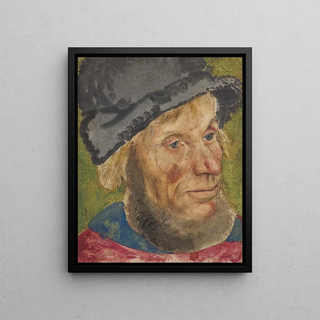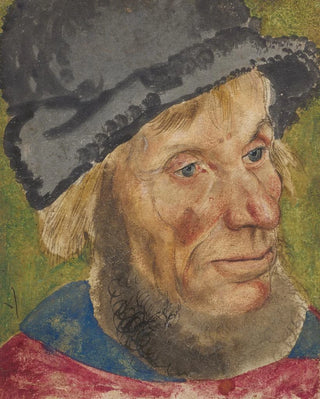Art print | Head of Peasant - Lucas Cranach the Elder


View from behind

Frame (optional)
Reproduction Tête de paysan - Lucas Cranach l'Ancien – Captivating Introduction
The "Tête de paysan" by Lucas Cranach the Elder is an iconic work that transcends a simple portrait to offer a poignant glimpse into the human condition during the Renaissance. This painting, both sober and emotionally charged, captures the essence of a typical character from German rural society. The peasant's features, marked by labor and hard work, tell a story of resilience and dignity. By contemplating this artwork, the viewer is invited to immerse themselves in a universe where the daily life of simple people is highlighted with rare depth. Cranach's ability to breathe life into this face, through delicate nuances and palpable expressiveness, testifies to his undeniable talent.
Style and uniqueness of the work
Cranach's style is characterized by meticulous attention to detail and a color palette that evokes both warmth and melancholy. In the "Tête de paysan," shadows and lights are skillfully manipulated to give relief to the subject's face, accentuating the wrinkles that testify to years of toil. The simplicity of the background highlights the character, without distraction, allowing the viewer to focus on the expression and emotions emanating from it. Every brushstroke seems loaded with meaning, revealing not only the peasant's external appearance but also an intimacy that resonates with anyone who has known struggle and perseverance. This work, through its psychological depth and realism, stands out from the idealized portraits of the period, offering an authentic vision of rural life.
The artist and his influence
Lucas Cranach the Elder, born in 1472 in Saxony, is one of the most influential painters of the German Renaissance. His work is marked by a unique ability to capture the nuances of human nature, whether noble or peasant. Cranach mastered blending the Flemish tradition of portraiture with a nascent German sensibility, laying the foundations for a style that would influence many artists. His engagement with the humanist ideas of his time, as well as his role as

Matte finish

View from behind

Frame (optional)
Reproduction Tête de paysan - Lucas Cranach l'Ancien – Captivating Introduction
The "Tête de paysan" by Lucas Cranach the Elder is an iconic work that transcends a simple portrait to offer a poignant glimpse into the human condition during the Renaissance. This painting, both sober and emotionally charged, captures the essence of a typical character from German rural society. The peasant's features, marked by labor and hard work, tell a story of resilience and dignity. By contemplating this artwork, the viewer is invited to immerse themselves in a universe where the daily life of simple people is highlighted with rare depth. Cranach's ability to breathe life into this face, through delicate nuances and palpable expressiveness, testifies to his undeniable talent.
Style and uniqueness of the work
Cranach's style is characterized by meticulous attention to detail and a color palette that evokes both warmth and melancholy. In the "Tête de paysan," shadows and lights are skillfully manipulated to give relief to the subject's face, accentuating the wrinkles that testify to years of toil. The simplicity of the background highlights the character, without distraction, allowing the viewer to focus on the expression and emotions emanating from it. Every brushstroke seems loaded with meaning, revealing not only the peasant's external appearance but also an intimacy that resonates with anyone who has known struggle and perseverance. This work, through its psychological depth and realism, stands out from the idealized portraits of the period, offering an authentic vision of rural life.
The artist and his influence
Lucas Cranach the Elder, born in 1472 in Saxony, is one of the most influential painters of the German Renaissance. His work is marked by a unique ability to capture the nuances of human nature, whether noble or peasant. Cranach mastered blending the Flemish tradition of portraiture with a nascent German sensibility, laying the foundations for a style that would influence many artists. His engagement with the humanist ideas of his time, as well as his role as






